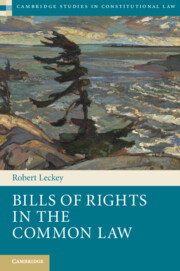Book contents
- Frontmatter
- Dedication
- Contents
- Acknowledgements
- Table of cases
- Introduction
- 1 Against bill-of-rights exceptionalism
- 2 The common law, judging, and three bills of rights
- 3 Judicial review of legislation before bills of rights
- 4 Bills of rights and other means of accessing judgment
- 5 Putting the strike-down in its place
- 6 Remedies from text to practice
- 7 Improving the system and engaging the legislature
- 8 Rethinking remedies and constitutional supremacy
- Conclusion
- Bibliography
- Index
6 - Remedies from text to practice
Published online by Cambridge University Press: 05 May 2015
- Frontmatter
- Dedication
- Contents
- Acknowledgements
- Table of cases
- Introduction
- 1 Against bill-of-rights exceptionalism
- 2 The common law, judging, and three bills of rights
- 3 Judicial review of legislation before bills of rights
- 4 Bills of rights and other means of accessing judgment
- 5 Putting the strike-down in its place
- 6 Remedies from text to practice
- 7 Improving the system and engaging the legislature
- 8 Rethinking remedies and constitutional supremacy
- Conclusion
- Bibliography
- Index
Summary
Building on what judges do when resolving rights cases, this chapter looks at the reasons or justifications they provide in doing so. It presents the factors that judges have identified as conditioning their remedial determinations. Quantitative analysis of wins and losses under a bill of rights will not register such qualitative factors, but they are part of a bill of rights's application. Crucially, judges' discussions of their powers to remedy violations of rights gesture to the ideas that underlie the gap between text and practice.
It is worth clarifying the relation of discretion to remedies. Bills of rights endow judges with various remedial powers. The Constitution of South Africa empowers judges to make orders that are ‘just and equitable’. On virtually any reading, such language signals a strong discretion. Similar discretion inheres in the UK Parliament's statement, in the Human Rights Act, that a court unable to read legislation compatibly with rights ‘may’ declare its incompatibility. By contrast, other provisions use a register more characteristic of non-discretionary duty. In this way, the South African Constitution affirms that a court in constitutional matters ‘must declare that any law or conduct that is inconsistent with the Constitution is invalid to the extent of its inconsistency’. The supremacy clause in Canada declares that unconstitutional legislation ‘is…of no force or effect’ to the extent of its constitutional inconsistency. Similar in its imperative voice, though different in substance, the Human Rights Act imposes a duty by which legislation ‘must be read and given effect’ compatibly with rights, ‘so far as it is possible’.
Allan, for one, rejects the language of discretion in the context of vindicating rights. He denies that judges in the UK may choose between the competing ‘remedies’ of sections 3 and 4. As this chapter recounts, however, specifications such as ‘what is possible’ or ‘the extent of the inconsistency’ are not self-applying. They press judges to resolve debatable questions – which judges perceive as presenting choices.
- Type
- Chapter
- Information
- Bills of Rights in the Common Law , pp. 123 - 150Publisher: Cambridge University PressPrint publication year: 2015



